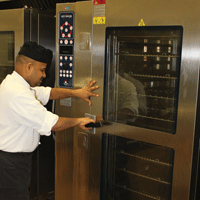Foodservice operators work in a world where budgets are getting tighter, margins are getting thinner and trained staff are getting harder to keep — or even find. For many, one of the best ways to maintain stability and cost savings in the kitchen is to invest in labour-saving equipment.
Whether cooking with multi-purpose ovens or countertop appliances, the right equipment can make culinary teams efficient while keeping the head count in check. Tawfik Shehata, executive chef at the International Centre in Mississauga, Ont., puts it succinctly when he says: “You don’t have nearly as much turnover on your equipment.”
Labour is one of the two major cost-control expenses in a restaurant, accounting for 28 to 31 per cent of sales, explains Shawn Jackson, COO and founder of Crush Strategy foodservice consultants in Mississauga, Ont. “The other is food and beverage costs, which can run from 23 to 30 per cent of sales. In an ideal world, you want those numbers combined to be below 60 per cent. The problem is the cost of labour is going up.”
While small and fine-dining establishments can pass on costs to customers, that’s not the case for quick-service or other high-volume establishments. “They can’t achieve the price points to pay for added labour costs,” Jackson notes.
He believes the biggest efficiency game-changer is combi-ovens. “I’d say they would be the first, most dynamic pieces of equipment that assist in terms of consistency and labour controls. That’s because they can be a convection oven, a steamer; they can even do frying. A lot of establishments are really taking a look at them now.”
For the International Centre’s Shehata, combi-ovens are one of the main reasons he can operate with a mere five full-time kitchen staff, along with a roster of part-timers who come in for events. The Centre has invested $2 million in improvements and efficiencies for its kitchen equipment, including four combi-ovens, one of which can be used as a smoker, plus one in a satellite kitchen.
“We couldn’t manage without them. They are very, very efficient from both an energy and staffing standpoint,” Shehata notes. “Whenever they’re used, they are on timers, so you don’t have to keep coming back and opening the doors to check on things. Once it’s programmed, you don’t have to worry about it shutting off or forgetting anything.”
While combi-ovens may cost $60,000 a unit, the labour savings more than make up for the cost, he adds. “It also saves a lot of things from spoiling, because they cook consistently no matter how large the volumes. We can always rely on that equipment.”
Darren Brown, executive chef at the Fairmont Pacific Rim in Vancouver, also enjoys using a combi-oven. “It allows us to do centralized production for all our restaurants and makes us much more efficient. What the ovens bring is precision, control and flexibility. With the [Rational] Whitefficiency model, I can load a rack of eggs on the top shelf, bacon in the middle and toast on the bottom, and it will cook all three at different temperatures at the same time.”
The Fairmont chef also uses the Rational units for sous-vide cooking. “Sous vide is a really good way to minimize your labour, because you can do the focused, preparation work when you’re not under pressure and then execute in a rush.”
Another “fantastic asset” for Shehata is the two large capacity cook-and-hold ovens. These very low temperature cabinets are used to slow-roast large cuts of meat at 225°F to 250°F over the course of 12 hours. “It’s simple for the team. You put the meat in, insert a probe to monitor the internal temperature and set the timer.” Once it reaches the desired temperature, the oven automatically reverts to a holding temperature of 160°F until it’s time to serve.
And, once the cooking is complete, the blast chiller is a useful tool, too. At the International Centre, it helps that the Alto-Shaam combi-oven, chiller and cook-and-hold equipment is standardized. “That means we can take a rolling rack out of the Combitherm and roll it into the blast chiller,” Shehata explains.
Labour-saving technology is so integral to foodservice these days that the new School of Hospitality and Culinary Arts at Red River College in Winnipeg is ensuring its students are well-trained on combi-ovens and induction units. “Induction cooking is becoming increasingly popular in the industry,” notes Jeff Gill, acting chair of Hospitality. “We also have a number of Rational combi-ovens in our nine cooking labs.”
Knowledge of labour-saving equipment is desperately needed in an industry suffering from constant labour shortages. “We can’t produce enough people for that sector,” says Gill. “That’s why some of the newer equipment is a necessity, because it allows you to be more efficient with your use of labour while taking out a lot of the guesswork.”
Labour savings can also be found in countertop mainstays such as food processors and blenders, notes Jackson. “The savings can be substantial if you don’t have to have someone chopping for two hours. All of that prep work can be done in a minimal time frame.”
And, of course, optimizing a kitchen layout and design is integral to minimizing labour. “You have to make sure everything is accessible to your staff, so you can expedite the process of putting meals out while utilizing a smaller line,” Jackson adds.
In the end, it pays to do your homework, says the Crush consultant. “Some of these pieces of equipment are expensive, so you need to know what setups work best. It doesn’t always have to be the largest or smallest. Your footprint and layout however must be pretty precise to assist with the labour process.”
Keep Reading
Smoothie Wars: Competition Heats Up
Multimedia Entertainment Systems Are Becoming a Point of Competitive Pride
SIAL Canada to Showcase Latest Foodservice Trends





















